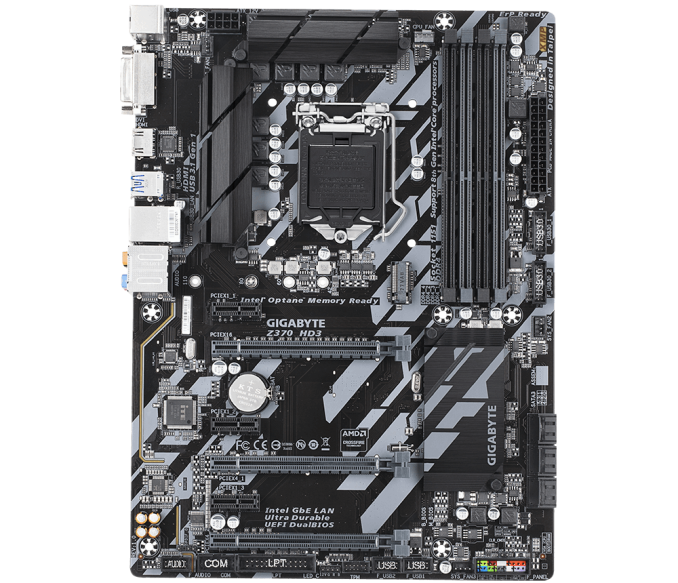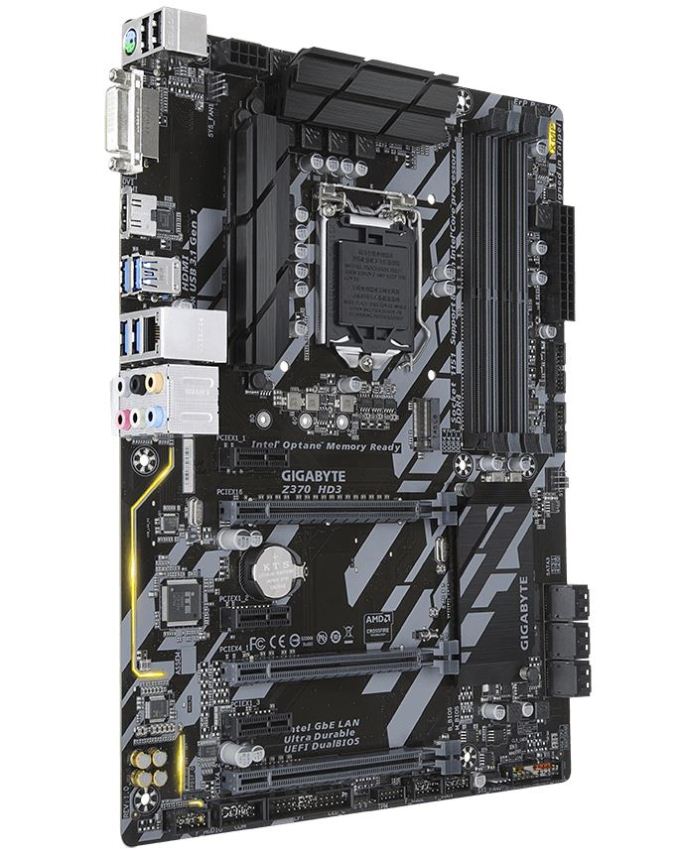Analyzing Z370 for Intel's 8th Generation Coffee Lake: A Quick Look at 50+ Motherboards
by Ian Cutress, Anton Shilov, Joe Shields & Gavin Bonshor on October 20, 2017 2:00 PM ESTGIGABYTE Z370 HD3
The last of the nine GIGABYTE boards for this article is the entry-level Z370 HD3. The HD3 slides in below the HD3P, and despite the minor name difference, has a more different layout than expected. The HD3 is a board for the budget conscious looking to get into the platform at the lowest entry point. For example, the HD3 does not have USB 3.1 (10 Gbps) ports on the board, has only one M.2 slot instead of two or three, and doesn't have slot reinforcement on any PCIe or DIMM slot.
The HD3's appearance is nearly a carbon copy of the HD3P, except the grey stenciling is on the board and chipset heatsink only, and is not on the VRM heatsinks. The memory slots are the same two black and two gray, while all PCIe slots (none with reinforcement) are grey with the PCIe x1 slots in black. The PCH heatsink is also carried over. The only non-standard LEDs on the board is the audio separation line and the XMP notification in the top right-hand corner.
Users still receive the full complement of four memory slots supporting up to 64GB in capacity, while GIGABYTE states a maximum supported speed of up to DDR4-4000. For PCIe, the two full-length slots are wired to run in an x16/x4 configuration driven by the CPU with the third also running at x4 speeds but fed from the chipset. That said, there is only support for 2-Way AMD Crossfire or AMD Quad-GPU Crossfire (2x dual GPU cards) as SLI requires x8 per slot minimum.
As mentioned earlier, the HD3 is down to one M.2 slot, the least on any of the Gigabyte boards. For most users that might be of little concern as they only have one M.2 based drive. The board contains six SATA ports supporting RAID 0, 1, 5, and 10, rounding out storage connectivity. There are a total of four fan headers on the board, with one to the right of the VRM heatsink on top, another close to the EPS 12V connector, while the other two system fans are at the bottom of the board and on the middle right side just above the SATA ports. The included Smart Fan 5 application is still able to control the hybrid PWM/Voltage controlled headers. The audio codec on the HD3 steps down to the ALC892 codec. It also does not have EMI shielding but the board design still separates the boards analog audio components from the digital components on the PCB. For networking, one of Intel's GbE LAN chips covers the network side for the HD3.
The USB side of the house is going to be fairly straightforward. From the chipset, the board has eight USB 3.1 (5 Gbps) ports with four on the back panel and for more available through internal USB headers. Users will also find six more USB 2.0 ports with two on the back panel, and four more available through internal USB headers. There are no USB 3.1 (10 Gbps) ports on this board, allowing for cost savings, although users can still purchase USB 3.1 (10 Gbps) PCIe cards to expand functionality if needed. The back panel IO also includes a combination PS/2 port, a DVI-D video output, a HDMI video output, and the audio jacks.













83 Comments
View All Comments
sor - Friday, October 20, 2017 - link
Damn. At least key it differently and call it LGA1151v2 or something.The changes are so minimal it really does seem like planned obsolescence. Does it really need more power pins to support new chips with the same power envelopes? Really? They couldn’t handle that on the CPU PCB?
KaarlisK - Saturday, October 21, 2017 - link
Actually it is ~1.5 times peak current with the same average power envelope, so yes, they need the change.If they had not brought the launch forward and just launched together with the cheap chipsets, there would be far less complaints.
sor - Saturday, October 21, 2017 - link
Where did you find information indicating current has increased 50%? I just spent about ten minutes trying to find a reference backing that up, perhaps something indicating the 8 series operates at a much lower voltage within same TDP, which would translate to higher current but they seem to operate in the same 1.2-1.3v range.You’re not just assuming they draw more current because they have two more cores, are you?
KaarlisK - Sunday, October 22, 2017 - link
Notice the difference between average and peak.And the information is in publicly available documents. I did not bother to look it up, but others have, for example: https://forum.beyond3d.com/threads/intel-coffee-la...
Crono - Saturday, October 21, 2017 - link
Nice roundup. That's a lot of motherboards to spec and summarize. I especially appreciate the handy chart at the end, it's a good, quick-and-dirty comparison tool.Landcross - Saturday, October 21, 2017 - link
You guys forgot 2 new Z370 boards from Supermicro :)https://motherboarddb.com/motherboards/?chipset=19...
Xpl1c1t - Sunday, October 22, 2017 - link
The mITX board looks incredible.+ Low ESR Tantalum capacitors! (first time seeing them on VRM duty on a mainboard)
+ HDMI 2.0
+ 2x M.2 Slots
+ USB 3.1 Type C
+ Optical SPDIF
- RGB.......
MadAd - Saturday, October 21, 2017 - link
Great write up but for me its just another depressing generation of oversized, overpriced ATX form factor offerings on which the vast majority of users wont even plug a second gpu into, with the smaller and more size appropriate FF represented as a minority afterthought.With all the progress of PCs since the 90s whod have thought that I could still use the same ATX case today while every single other component (from floppy drives to 2d Mattrox cards) have long gone to the recyclers. I find it so annoying how manufacturers have stuck on this prehistoric gargantuan case size with the other sizes being an afterthought. It feels like like stifled innovation while everything else is moving on.
rocky12345 - Saturday, October 21, 2017 - link
Great article and a lot of work put in to get it out for us to read thank you.My only issue is and it is nit your fault is why these companies feel the need to totally blanket the market with basically the same boards just a different model number and basically a few tiny changes and spray paint it a different color and use the word gaming and put something x or x1 or k,k3 etc etc. For crap sakes just release three models not 7-10 models of the same crap it is pretty much just greed I guess.
The whole market is like this now with anything computer related of and if it has the words GAMING or RGB in it's got to be good for sure. My fav is that gaming mouse pad next it will have RGB lighting in it...lol
CitizenZer0 - Wednesday, October 25, 2017 - link
Agreed